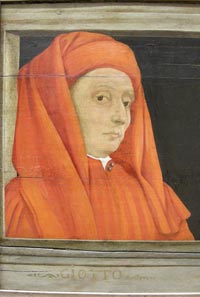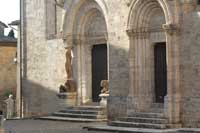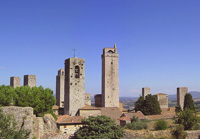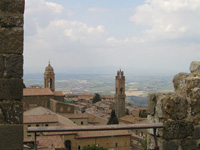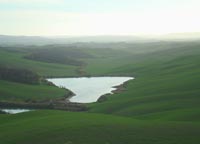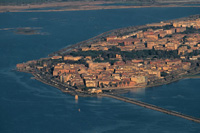Though the chapel was ostensibly a family oratory, it served some public functions related to the Feast of the Annunciation. Apart from Giotto's work, the chapel is unornamented and features a barrel vault roof. Giotto's Last Judgment covers the entire wall above the chapel's entrance and includes the aforementioned devotional portrait of Enrico. Each wall is arranged in three tiers of fresco groups, each with four two-meter-square scenes. Facing the altar the sequence begins at the top of the right hand wall with scenes from the life of the Virgin, including the annunciation of her mother and the presentation at the temple. The series continues through the Nativity, the Passion of Jesus, the Resurrection, and the Pentecost. The panels are noted for their emotional intensity, sculptural figures, and naturalistic space. Between the main scenes Giotto used a faux architectural scheme of painted marble decorations and small recesses.
Frescoes in the Arena Chapel
Scenes from the Life of Joachim
Scenes from the Life of Christ
The Seven Virtues |
|
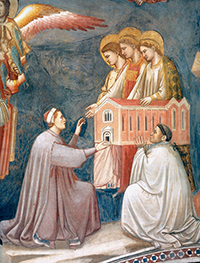
Model of the Chapel offered up to the Virgin Maryby Enrico Scrovegni, detail of The Last Judgemen, Scrovegni Chapel, Padua |
Scenes from the Life of Joachim
1. Expulsion of Joachim from the Temple
2. Joachim among the Shepherds
3. Annunciation to St Anne
4. Joachim's Sacrificial Offering
5. Joachim's Dream
6. Meeting at the Golden Gate |
|
|
| |
|
|
Scenes from the Life of the Virgin
7. The Birth of the Virgin
8. Presentation of the Virgin in the Temple
9. The Rods Brought to the Temple
10. Prayer of the Suitors
11. Marriage of the Virgin
12. The Wedding Procession
13. God Sends Gabriel to the Virgin
14. Annunciation: The Angel Gabriel Sent by God
15. Annunciation: The Virgin Receiving the Message
16. Visitation |
|
|
Scenes from the Life of Christ
17. Nativity: Birth of Jesus
18. Adoration of the Magi
19. Presentation at the Temple
20. Flight into Egypt
21. Massacre of the Innocents
22. Christ among the Doctors
23. Baptism of Christ
24. Marriage at Cana
25. Raising of Lazarus
26. Entry into Jerusalem
27. Expulsion of the Money-changers from the Temple
28. Judas Receiving Payment for his Betrayal
29. Last Supper
30. Washing of Feet
31. Kiss of Judas
32. Christ before Caiaphas
33. Flagellation
34. Road to Calvary
35. Crucifixion
36. Lamentation (The Mourning of Christ)
37. Resurrection (Noli me tangere)
38. Ascension
39. Pentecost |
|
|
|
The Seven Virtues
40. Prudence
41. Fortitude
42. Temperance
43. Justice
44. Faith
45. Charity
46. Hope
The Seven Vices
47. Desperation
48. Envy
49. Infidelity
50. Injustice
51. Wrath
52. Inconstancy
53. Foolishness |
|
|
| |
|
|
|
Scenes from the Life of Joachim
|
|
|
| The individual scenes are composed in such a way that each stands as a picture in its own right, and yet each contains an impetus which passes from story to story in succession. Thus the narrative begins at the top left-hand of the south wall with the first scene from the life of Joachim, the Rejection of Joachim's Sacrifice. |
| |
|
|
|
1. Expulsion of Joachim from the Temple
|
|
|
| |
The elderly Joachim is denied entry to the temple, as he has remained childless. The architecture reinforces the priest's gesture of rejection, to which the saint replies with a saddened look. The sheep, as a sacrificial animal that has become superfluous, has a particularly touching effect.
The rejection of Joachim's sacrifice and his expulsion from the Temple occurred because of his childlessness. Here we are dealing with a true opening picture: the closed architecture of the temple introduces the first idea of solidity, while Joachim's dual movement brings this scene to a close, on the one hand, and on the other paves the way for the rest of the series, which finds a premature conclusion in the last picture of this register, the Meeting at the Golden Gate.
The action is also driven forward by the repetition of buildings. Thus the temple of the opening picture reappears in the fresco Presentation of Christ at the Temple.
|
|
|
| |
|
|
|
2. Joachim among the Shepherds
|
|
|
| |
Sad and introverted, Joachim arrives among the shepherds. Using the contrast between the lively sheep, the dog that greets him, and the knowing glances of the shepherds, Giotto elucidates his state of mind in the voluminous, closed form of the saint. |
|
|
| |
|
|
|
3. Annunciation to St Anne
|
|
|
| |
The miraculous encounter takes place in an obliquely set, box-like room. An angel appears in the window opening and announces the birth other daughter Mary to the praying Anne. Giotto illustrates the intimacy of the scene using the domestic objects, and particularly the contrast between interior and exterior - a maid sits spinning outside in front of the door. |
|
|
| |
|
|
|
4. Joachim's Sacrificial Offering
|
|
|
| |
In the open countryside, Joachim has sunk to the ground and catches sight of an angel, who indicates to him that his sacrifice has been accepted. Colour is used to establish a connection between these two figures, illustrating the miraculous nature of events. As so often, Giotto also employs a figure here who comments on the action — the praying shepherd. In his colorings, he is closer to the rocks and the animals. He too recognizes the hand of benediction in the sky. |
|
|
| |
|
|
|
5. Joachim's Dream
|
|
|
| |
Joachim is slumped in the shelter of the hut and the rock, asleep. The shepherds watch over him and their flock. One of them appears to see the celestial phenomenon - an angel bringing Joachim tidings of his impending fatherhood. Tremendous tension is created along the diagonal between the angel and Joachim, allowing us to comprehend what is happening.
Giotto's tendency to depict human figures almost as geometrical shapes is demonstrated by the way the sleeping figure of Joachim seems contained as if within a cube. The stillness of the scene is broken by the liveliness of the sheep. Here Giotto was perhaps inspired by his legendary youth as a Tuscan shepherd boy. |
|
|
| |
|
|
|
6. Meeting at the Golden Gate
|
|
|
| |
In the last fresco of the upper register the composition is concentrated on the encounter between Joachim and Anne: Joachim is accompanied by a shepherd, who is partly cut off in the fresco. On the one hand, Giotto uses this completely new device in painting to create the impression that the succession of pictures, intersected by the framework, would unfold before our eyes in one continuous procession. On the other hand, a figure cut short in such a manner increases the dynamics within the picture field and makes us focus on the action at its centre.
Even the verticals of the architecture and the golden arch of the city gate respectively illustrate and mirror the way the couple lean towards one another. The two meet on a bridge, on the border between the outside world and the security of the city. They embrace with great tenderness and kiss one another. The way in which the volumes of the figures fuse underlines the tenderness of the moment, in which the faces also melt, as it were, into one another.
The story of Mary's parents begins with a painful rejection and concludes with this intense encounter. The sensitive portrayal of their meeting already contains the germ for the start of the next narrative, which commences with the Birth of the Virgin Mary and which leads to the youth of Christ by way of the Bridal Procession of the Virgin.
|
|
|
| |
Anne and her companions have gone to meet Joachim. The spouses encounter one another on the bridge in front of the Golden Gate of Jerusalem, certain that they will now become parents. Everything around them seems to be affected by this — from the arches of the architecture, which appear to echo the posture of the couple, to the faces, which reveal very different responses. |
|
|
| |
The two elderly spouses recognize one another and their good fortune in their Meeting at the Golden Gate. It is the final picture of the upper register and, at the same time, an allusion to an event which is yet to come: the Birth of the Virgin Mary. |
|
|
| |
|
|
| |
|
|
|
| |
|
|
|
| |
|
|
| |
|
|
|
| |
|
|
|
| |
|
|
| |
|
|
|
Scenes from the Life of Christ
|
|
|
The youth of Christ and the story of his Passion are narrated on the two lower registers of the wall of the Scrovegni Chapel.
|
|
|
| The five scenes on the right wall represent the Nativity, the Adoration of the Magi, the Presentation in the Temple, the Flight into Egypt, and the Massacre of the Innocents. |
|
|
| |
|
|
|
| |
|
|
|
| After the scene of Judas' Betrayal on the triumphal arch wall, the story continues on the tier below, on the window-side (right side) of the chapel. Here we have a symmetrical arrangement (an outdoor scene flanked by two indoor scenes) of scenes from the Passion of Christ - the Last Supper, the Washing of Feet, the Kiss of Judas, Christ before Caiaphas, and the Flagellation. |
| |
|
|
|
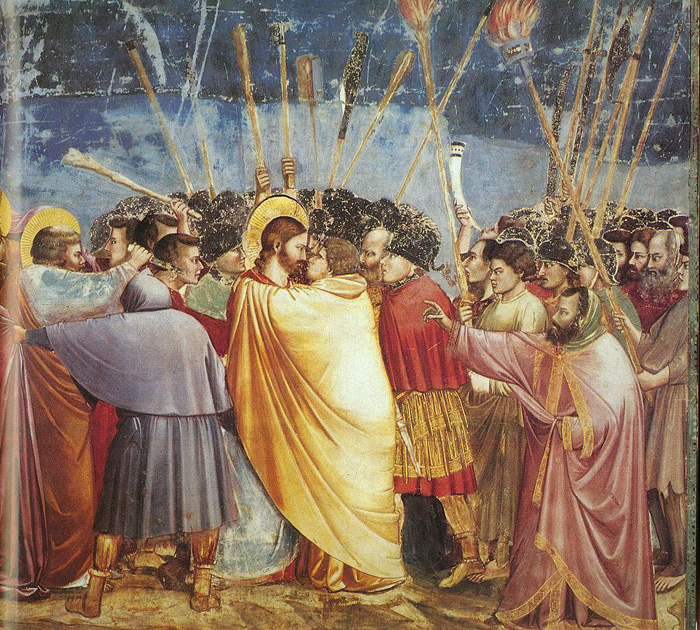 |
Giotto di Bondone, No. 31 Scenes from the Life of Christ: 15. The Arrest of Christ (Kiss of Judas), 1304-06, fresco, 200 x 185 cm, Cappella Scrovegni (Arena Chapel), Padua |
This dramatic scene takes place at night. Torches shine out among the sticks and halberds against the blue of the sky. The throngs of people crowd into the centre, towards Christ, who is betrayed by Judas' kiss. Every movement, even that of Peter as he cuts off the ear of an attacker, and every gaze heightens the tension of the central confrontation.
With the force of his body Judas presses against Christ, who appears to disappear beneath the traitor's cloak. This expresses the inevitable outcome of this overwhelming confrontation. Surrounded and hemmed in by numerous faces, the profiles of Christ and Judas almost collide. The two look at one another — the one with dignity and seriousness, the other full of malice. The whole drama of the event is captured in this infinitely long exchange of glances. |
| |
|
|
|
| |
| |
|
|
|
| The contrast between the caricature-like figures and the introverted Christ, who has had the royal mantle wrapped round him in mockery, could not be greater. Two completely different worlds are depicted in the one picture. As in all the scenes which follow his arrest, Giotto also shows Christ here as a changed character: submissive and lacking all vitality. |
| This detail shows the torturers of Christ in the Flagellation scene. |
|

|
| |
|
|
In the lower tier on the left wall are the Road to Calvary, the Crucifixion, the Lamentation, the Resurrection (represented by the Noli me tangere scene instead of the three Marys at the tomb), the Ascension, and the Pentecost.
|
 |
|
|
[1] The Italian painter Giotto di Bondone was born in Vespignano near Florence, where he died. He is often appreciated for his innovations in painting. Painting had got into a rut, and Giotto created a first impetus for the Italian Renaissance.
Giotto imbued his figures with personality and tried to give expression to their faces and bearing, as is clearly visible from his major work: the frescoes in the Scrovegni Chapel in Padua, a.k.a. the Arena Chapel. Giotto may very well have been the first painter succeeding in creating unified compositions: there is unity between the figures and their surroundings and unity among the figures, interacting as they do through gesture and emotion.
Giotto's work is celebrated during his lifetime. Dante proclaims him larger than Cimabue, the Italian artist considered the most important until then, and probably Giotto's teacher.
Few works may be ascribed to him with absolute certainty: a series of frescoes in Padua, more frescoes and altarpieces in the Santa Croce in Florence and a painting of the Madonna, presently on display in the Uffizi in Florence. Most likely the famous fresco series on the life of Saint Francis in the St Francis of Assisi Church is by Giotto too.
Giotto is also involved in the design of buildings. He collaborates on the Dome of Florence and designs the accompanying bell tower.
The portrait here is a detail from The five Masters of the Florentine Renaissance – a work begun by Paolo Uccello.
|
|
|

Derbes, Anne, and Mark Sandona. The Usurer's Heart: Giotto, Enrico Scrovegni, and the Arena Chapel in Padua. Pennsylvania State University Press, 2008.
Basile, Giusepp, Giotto: Frescoes in the Scrovegni Chapel, Skira, 2003
Cole, Bruce, Giotto: The Scrovegni Chapel, Padua, New York, 1993.
|





